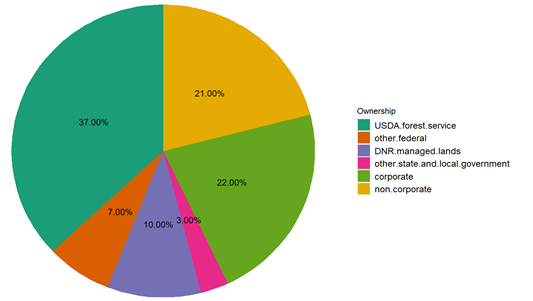WA State Forestry
Washington State’s 22 million acres of forestland can be broadly divided into six ownership types, the dominant being USDA forest service forests (aka, the USFS forests), comprising 37% of Washington’s overall forestlands. Of this 37%, approximately 7% consists of the reserved forests and is home to most of the State’s old-growth forests, and most of the remaining USFS forests are plantations, previously managed for timber. Private forestlands are divided into ‘corporate forests’, comprising 22% of the State’s forests, and non-corporate forests comprising 21% of the forestland. Approximately 10% of the State’s forestland is owned by the Department of Natural Resources (WA-DNR). The remaining forests are owned by other federal agencies, like the fish and wildlife service, the department of defense, and county and municipal corporations, to name a few. Approximately 70% of Washington’s wood production comes from the 22% intensively managed corporate forests, and the remaining from the WA-DNR and non-corporate-private forestlands.

Washington’s forests managed for harvested wood products (a.k.a., working forests), including private and state-owned forest lands, are generally sustainably managed. CINTRAFOR research shows that Washington State’s working forests are effective carbon sinks, sequestering more carbon in its landscape, even after deducting all the natural mortality and harvest removals. Washington State has a vibrant forest products industry, and CINTRAFOR researchers work very closely with the State’s forest products industry and help them access the global market.
Research Briefs
Global warming mitigating role of working forests in Washington State
